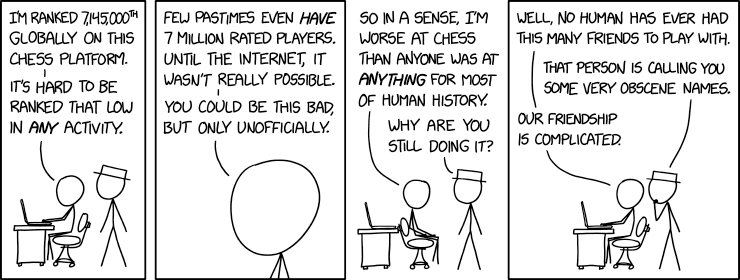I sometimes provoke outraged reactions in certain quarters when I claim that it isn't possible to disentangle lesbian history from transgender history. But this article gets into the type of reason why I say that. (And I'll have an entire chapter in my book digging deeper into this topic.) What lies at the heart is that one strain (and there are others) of historic understanding of and reaction to a female-bodied person desiring another female-bodied person is to simultaneously force them into a heteronormative framework and then punish the "designated male" participant, not for homosexuality, but for gender transgression. We see this in contexts like the one discussed in the present article, where behavioral gender-crossing of some type is involved, but we also see it in the long history of investigating women expressing same-sex desire for signs of physiological masculinity.
Under a heteronormative framework, transness is far more legible and comprehensible than homosexuality. Thus, regardless of what identity models the people involved had available or adopted as their own, there has been a regular (though variable in strength) pressure to accept a trans framing. (This continues up through the late 19th century sexologists' conflation of trans and homosexual experiences under the "gender invert" label.) Even apart from the anachronism of applying current identity categories to historical people, this complicates attempts to neatly categorize historic people with regard to degrees/types of "female masculinity." If a female-bodied person could be labeled "masculine" for being intelligent, brave, strong, tall, athletic, honorable, independent, politically savvy, not conventionally pretty, etc. etc., then how do you trace a line between transmasculinity and accepting cultural brainwashing? (Please note: I am NOT implying that transmasculine identity is due to "cultural brainwashing." I'm saying that some people are trans men and some people have been labeled "unfeminine" for not aligning with certain cultural stereotypes.)
When I get negative reactions to my (admittedly provocative) statement about the entanglement of lesbian history and trans history, my impression is that some of it comes from assuming that I'm talking about trans women in lesbian spaces, whereas mostly I'm talking about the ambiguous classification of female masculinity. But when you come down to it, the historic people who reacted to a female-presenting person desiring a woman by accusing her of being "really a man, in some fashion" aren't that different from the modern bathroom police who see a female-presenting person who deviates in some way from a narrow definition of femininity and accuse her of being "really a man." And I wish more people were more familiar with the deep history of gender policing and the damage it causes.
# # #
Narratives of the lives and “adventures” of passing women were popular in 18th century British culture, purporting to provide biographies of women who lived as a man for some period of time, including: Hannah Snell, Christian Davies, Jenny Cameron, Anne Bonny & Mary Read, Charlotte Charke, Elizabeth Ogden, an unnamed “apothecary’s wife” whose story is appended to the English translation of the life of Catharine Vizzani, and Mary Hamilton whose story inspired the label “female husband” for those passing women who engaged in relationships with other women.
Despite being based on actual lives, and despite the assertion that each was “unique,” the stories as published became highly conventional, with certain fixed elements. One such element (the focus of this paper) is some type of erotic interaction between the passing character and another woman, either actively courting the woman or becoming the object of the woman’s interest (and usually delighted in so being).
There are two other contexts in popular culture of the time that feature cross-dressing women but do not include these erotic encounters: the “woman warrior” plot in which a woman typically dresses as a soldier to follow (or pursue) a male lover; and cross-dressing subplots in novels.
These erotic encounters in passing woman narratives raise and address questions about the relationship between gender and sexuality, and not always in ways that align with the supposed “lesson” such stories provided to the public. Previous scholarship on the genre usually addressed one of two angles: the challenge to stereotypes of gendered ability (Friedli, Dugaw, Wheelwright, Dekker & Van de Pol); or their situation within ideas of female homoeroticism in general (Lanser, Donoghue, Moore).
This article looks at how passing woman erotics disrupt an assumed correspondence between gendered social role and the object of desire. The author notes that 18th century attitudes did not assume an automatic connection between cross-dressing and homoeroticism and, in fact, to some extent passing woman stories act to reinforce heteronormativity, even as they question it. Further, they support an assumed principle that “gender difference must precede desire.”
The author cautions that passing woman narratives should neither be assumed to represent homosexual desire nor that they should be assumed to erase it entirely. Further, she argues that rather than “gender norms [being] defined through sexuality” these texts are part of an active process of creating those norms. The stories’ insistence on making erotic connections between cross-dressed women and normative women in pseudo-heterosexual relations act to separate masculinity (as a gender), with its concomitant orientation of desire toward women, from biological maleness. And it is this separation that creates a potential reading of female masculinity as tied to homoeroticism.
[Note: I’m skeptical about the claim that this is a process being established in the 18th century, because there is a very long historical tradition of associating desire for women with an assumption of masculinity, such that female-oriented desire triggered investigation into the potential masculinity of a female-presenting woman.]
The formulaicness of passing-woman erotic plots creates an expectation within the audience for such an encounter at any time a cross-dressing woman is introduced. In one version, the passing woman decides to court a woman (or women) either as a test of her passing, as a lark, or in active support of the strength of her disguise. And in the standard narrative, she is successful. The object of the courtship falls in love and pledges herself to the passing woman, often preferring that relationship to other rivals. The courtships may be presented hyperbolically or with a certain sly satire on conventional courtship rituals. But the essential element is that the courtship and its reception occur within a context where the two are understood to be man and woman.
This same formula holds when the normative woman initiates the courtship; it occurs within a context involving gender difference. An interesting doubled example is the brief description of the pirates Mary Read and Ann Bonny, when both are cross-dressing and each believes the other to be a man. In order to shift from desire to an active relationship, Bonny reveals her sex to Read (thereby establishing an assumed gender difference), only to have Read reveal her own sex, thus negating (within the narrative) the erotic potential. [Note: Compare a similar double-disguise plot in the play Gallathea, in which desire is sparked in both disguised women when they believe the beloved is male, that desire is challenged when both reveal their sex, but the desire outlasts the reanalysis that it is same-sex.]
The usual resolution of a gender reveal is that the normative woman’s desire evaporates and the previous desire is either reanalyzed as a good joke or an act of fraud. Here, though, we start seeing cracks in the façade. In the Jenny Cameron narrative, after Jenny reveals her sex to avert a duel with her rival for the girl’s affections, the girl immediately decides to marry the rival, lest she make a similar mistake in the future—that is, acknowledging the potential for her to again fall in love with a female-bodied person under the necessary masculine presentation.
A second type of resolution occurs when the passing woman concludes that the relationship is “impossible” (despite wishing that it were possible) and breaks off the courtship concluding that it “could not go beyond a platonick Love.” That is, the passing woman reciprocates the desire but chooses not to pursue it (and may or may not reveal her sex to her beloved). Here we find another distinction in how the narratives are presented. A passing woman who steps back from a homosexual relationship is typically presented as heroic and admirable (at least in that context, even if she may not be in other contexts).
In contrast, the third type—stories in which the passing woman continues to pursue the relationship, up to and including marriage and a sexual relationship—frame the passing woman as deceptive and fraudulent if the sexual relationship shatters the myth of "impossibilities." The classic example is Mary Hamilton.
Type 2 and 3 both challenge the idea that sexual difference is necessary for erotic desire (although the type 3 may frame the passing woman as mercenary rather than besotted), even if gender difference is still presented as essential. If is rare for the passing woman to reject the courtship or reveal her sex due to being horrified, disgusted, or simply uninterested. An essential part of the narratives is to depict the normative woman as desirable and (for all practical purposes) eligible. Rather, when the passing woman breaks things off, it is due to believing the next step (consummation) to be “impossible.”
Here, the passing woman narrative confronts the female husband narrative, in which that supposed impossibility is overcome. Now a different contrast in reception emerges: condemnatory narratives in which the female husband uses an artificial penis to overcome the “impossibility” and more neutral narratives in which some other means is used to side-step the question of consummation. It is this distinction in reception, Braunschneider argues, that works to help construct the normative relationship of gender and sexuality. It isn’t that desire can never precede gender difference, and it isn’t that the consummation of female homosexual relationships is literally impossible, but that when these principles are violated the narrative condemns them and frames the passing woman as monstrous and unnatural.
The judgement of the narratives is not based on the biological sex of the persons involved, but on the performed gender. The texts clearly assume—indeed, depend on—the audience knowing that the supposed “impossibilities” are, in fact possible, for key aspects may be provided only by implication or circumlocution. Thus, they create and acknowledge a space in which female-bodied people can desire each other and can consummate that desire. They simply define those possibilities as unacceptable.
A particularly convoluted example is offered to demonstrate the reductio ad absurdum of this program, contrasting what the participants in the scenario “know” versus what the narrator and the audience “know,” and how that knowledge shapes the presentation of the scenario. As long as the participants in the narrative “know” that an interaction is male-female, it is treated positively by the narrator, or at least as natural and expected, even though the narrator (and audience) “know” that the interaction is same-sex. At the same time, the passing woman is given a pass [pun intentional] on behavior that would be unacceptable in a man (such as abandoning their girlfriends without a qualm) because the alternative (continuing the relationship) would be unacceptable in a woman. The audience reception of the character shifts between treating her as a man and as a woman in inconsistent (but formulaic) ways, sometimes following the narrator’s “knowledge” that she is a woman, sometimes following the other characters’ “knowledge” that she is a man.
The same formulaic inconsistency occurs when it comes to sexual relations. When Mary Hamilton’s narrative follows her through one wedding night in which she doesn’t have her “device” available, wherein her flustered embarrassment is treated sympathetically (although in a mocking way), followed by clearly condemnatory descriptions of the sexual relations she engages in when the “device” is involved—but only after her wife discovers the truth. Her relationship becomes “vile” and “criminal” not only when one specific sexual technique is employed, but when it is known by the partner to be employed. That is, so long as Hamilton’s wife believes she is married to a man, the marriage is successful. When the relationship is known to be same-sex (by both participants) its nature is treated as being materially changed.










 Unlike the Sugar Gem oranges, this watermelon was sweeter than a regular ol’ watermelon. Not only that, but the label boasts a rich, red flesh. I thought it may have been all talk, but lo and behold it was indeed very red! I bought this one for six dollars, which is pretty much the exact same cost as a regular watermelon, and it’s roughly the same size, so I’d say you should go ahead and buy this one over the regular ones if you are someone who prefers a juicier, sweeter watermelon.
Unlike the Sugar Gem oranges, this watermelon was sweeter than a regular ol’ watermelon. Not only that, but the label boasts a rich, red flesh. I thought it may have been all talk, but lo and behold it was indeed very red! I bought this one for six dollars, which is pretty much the exact same cost as a regular watermelon, and it’s roughly the same size, so I’d say you should go ahead and buy this one over the regular ones if you are someone who prefers a juicier, sweeter watermelon.
